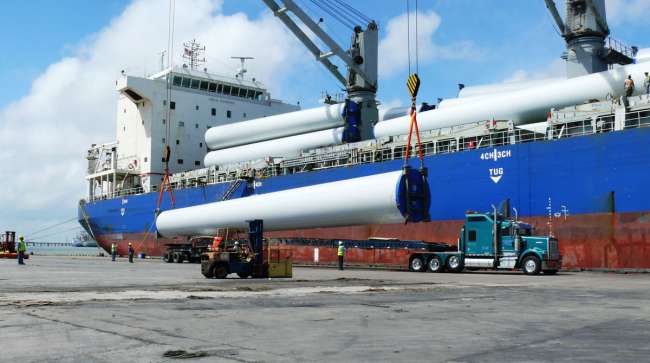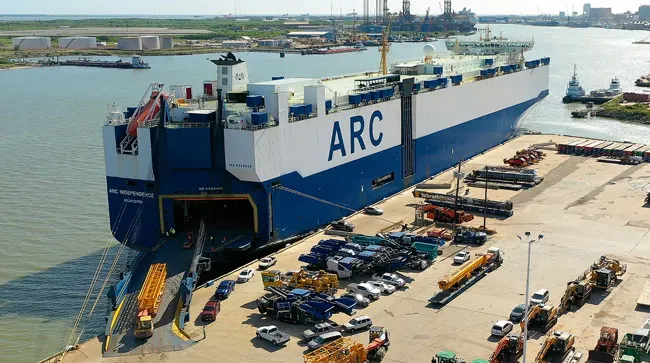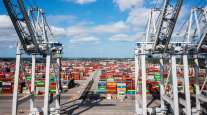Staff Reporter
Port of Galveston Expands to Boost Cargo Capacity by 2026

[Stay on top of transportation news: Get TTNews in your inbox.]
A $90 million Port of Galveston infrastructure project launched this summer aims to add 30 acres and a long berth by 2026, enabling the Texas facility to handle one-third more cargo.
“Roll-on/roll-off (ro-ro) and wind turbine pieces are two cargoes with big growth potential for the port, its stevedores, waterfront labor and the trucking industry,” Rodger Rees, Galveston Wharves port director and CEO, told Transport Topics.
“The Port of Galveston relies heavily on truck transportation to move more than 500,000 tons of cargo and provide provisions for the hundreds of cruise ships that will sail from Galveston each year,” he said. Hundreds of trucks enter the port annually for cargo operations.
Funded by port cash reserves and a $36 million grant from the Texas Department of Transportation, the project marks the first major investment in cargo infrastructure at the Port of Galveston in 50 years. Galveston Wharves held a groundbreaking ceremony July 24 for the start of phased-in construction expanding its West Port Cargo Complex.
Transtex CEO Mathieu Boivin discusses the environmental sustainability of auxiliary power units. Tune in above or by going to RoadSigns.ttnews.com.
Rees said port officials project that during the next few years, the cargo handling capacity will be boosted “by about a third.”
“We’re able to fund this work thanks to the tremendous growth of our cruise business and the historic state funding allocated for port infrastructure improvements,” he noted.
The Texas port’s robust ro-ro cargo business largely depends on truck transportation. In 2023, the port moved 497,701 tons of ro-ro cargo — mostly large construction and agricultural equipment. Trucks also moved some 17,500 new cars, primarily BMWs from Germany destined for central U.S. car dealerships.
RELATED: US Port Talks Kick Off in Effort to Avoid Strike
The project will add 30 acres to expand a cargo handling and laydown area. It also calls for demolishing an unused grain elevator, replacing decayed or unusable docks, and enclosing and filling slips at Piers 38/39 and 40/41. Concrete rubble from the old grain elevator at Pier 30/33 may be repurposed as material to fill the unwanted boat slips.

Construction and agricultural equipment is off-loaded at the Port of Galveston. (Galveston Wharves)
A new 1,424-foot-long berth, equivalent to the length of four football fields, is another addition. The enhanced cargo area is also expected to result in more shipments of wind turbine pieces.
“The port also is a big importer of wind turbine pieces, which are moved by truck and rail to build wind farms in the central U.S. and Canada. This year, the port is reaping the rewards of expanding its foreign-trade zone area with the import of hundreds of enormous wind turbine pieces,” Rees said.
Since August, 600 blades and tower pieces from Spain, Denmark and other European countries have arrived at the Port of Galveston. About 300 other wind turbine pieces are scheduled to arrive in the coming months.
“The pieces are offloaded from ships and loaded onto specially designed railcars and tractor-trailer trucks,” Rees said. “As wind pieces have increased in size, the port worked with the city and state transportation department to modify the turn lane onto the interstate feeder road to make it easier for trucks carrying wind turbine blades as long as 263 feet.”
Trucks also play a vital role in the port’s cruise business. A single cruise ship needs 35 to 40 tractor-trailer trucks loaded with provisions for every call at the port.
Want more news? Listen to today's daily briefing above or go here for more info
“In 2023, more than 350 ships called at the port. With the opening of a fourth cruise terminal in late 2025, that number will increase significantly,” Rees said. He added that tanker trucks carrying liquefied natural gas are needed to fuel the newly built, environmentally sustainable Carnival Jubilee. The LNG is transferred from trucks to a bunker barge that loads the fuel onto the ship.
During the groundbreaking ceremony at the port, Mayor Craig Brown said, “This is a great day for Galveston. Not only are we kicking off more than $90 million in cargo infrastructure improvements, the port is beginning construction this summer on its fourth cruise terminal, a $151 million investment in the port’s future. That’s a total of almost $250 million. This is a phenomenal milestone for our 199-year-old port and for the city of Galveston.”
RELATED: Francine Heads for Gulf Coast, Oil Drillers Evacuate Crews
Rees also noted that TxDOT has launched a program to build truck staging areas near ports in recognition of the critical role truck drivers have in U.S. maritime commerce. “The areas will improve trucker safety and efficiency by providing parking and staging areas with amenities like restrooms, lighting, picnic areas and vending machines,” Rees noted.





